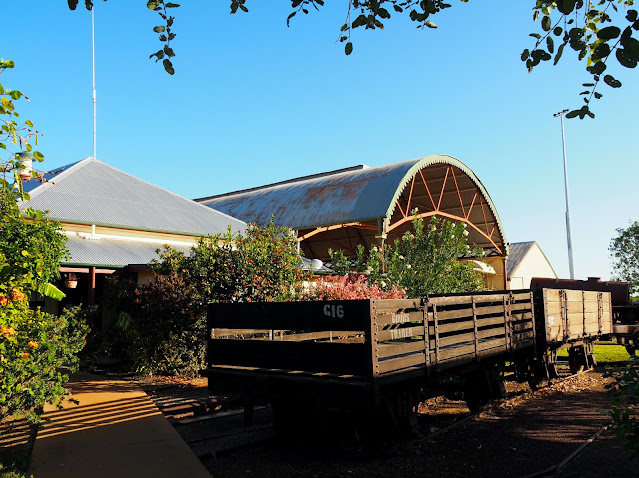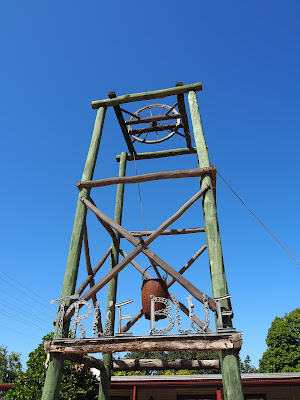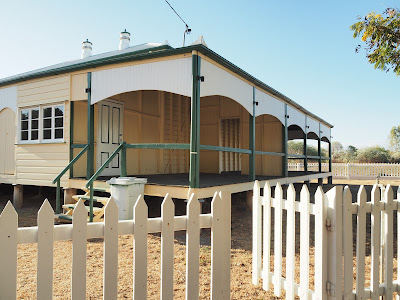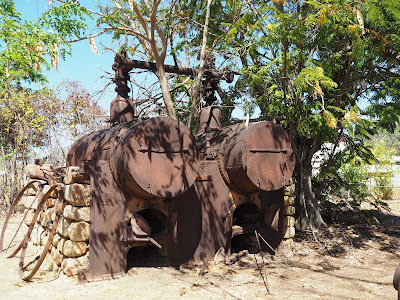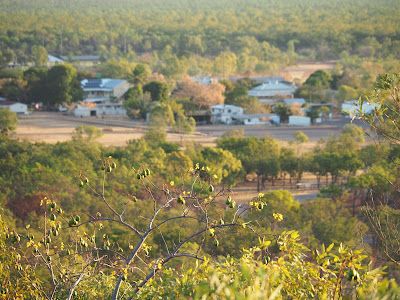Many twentieth-century North Queensland writers who were regular contributors to newspapers and popular journals seem to have had a curious affection for using pen-names, often writing under multiple different names. I've sometimes come across these writers when researching, and with by-lines like "Tramp", "Sundowner", "Bill Bowyang", "Bush Scribbler", "Battler", and "Viator", it's hard not to wonder just who were the people behind the names? Here's a small selection of writers whose identities I've been able to unearth.
 |
Charles Alfred Jenkinson ("Tramp"), 1927.
Photo: Fifty Years in North Queensland. |
"Tramp"The author behind the pen name Tramp was Charles Alfred Jenkinson (1872-1944). Jenkinson travelled widely throughout North Queensland and Papua New Guinea while working as a commission/insurance agent. Under the name Chas. A. Jenkinson, he reported on conditions in the north’s mining outposts as a special correspondent for a number of regional newspapers. For Cummins and Campbell’s Monthly Magazine, Jenkinson - under the name Tramp - wrote articles that ranged from historical chronicles of towns and pioneers, and descriptive ‘sketches’ of places he visited, to yarns based on his travel adventures. C&C's Monthly Magazine was an extremely popular and long-lived publication that ran for more than 30 years. Jenkinson also wrote for a journal entitled The Steering Wheel and Society and Home*, though he probably submitted the same material to this publication as he had submitted to the other outlets that published his work. Across more than three decades, Jenkinson wrote under the pen-names Tramp, Old Northerner, Queenslander, Solanum and A Miner.
* In 1939, this Queensland publication claimed to be the State's "oldest motoring and social magazine" and had been running for 28 continuous years.
"Viator"
Another regular contributor (and editor) of Cummins and Campbell's Monthly Magazine was William James Doherty (1867-1939). Doherty spent his early working life as a schoolteacher before turning his hand to journalism. His articles for the Monthly Magazine appeared under his own name, as well as under the pen name Viator (meaning wayfarer, or traveller). Doherty’s attempt at producing a history of early Townsville: The Townsville Book, is not considered to be a reliable historical account, but it is certainly full of good yarns. It seems that Doherty was aware of the book’s shortcomings, and noted in his preface that the source documents he consulted were very often ‘meagre, contradictory and sometimes improbable’. But on balance, he thought there were ‘grains of fact in every one of them’. As well as the name Viator, Doherty is known to have also written as WJD, Aurifer, Cudtheringa and Northern Star.
"Sundowner"
Many North Queenslanders will be familiar with Sundowner, as his regular column "Around the Campfire" was printed in the North Queensland Register for more than 60 years. Sundowner was Queensland-born Glenville Pike (1925-2011) - an
author, journalist, historian and publisher. He wrote at least 25 books, including Queensland Frontier, Pioneers' Country and Chasing the Rainbow: the Golden Gullies of the Palmer.
While
living in the Northern Territory, Pike started
the
North Australian Monthly, which ran from 1954 to 1965. The magazine's first edition carried the descriptive sub-heading: 'A Magazine devoted to publicising Tropical Australia North
of Capricorn - Articles: Topical, Historical, Geographical. Good Stories
- Illustrations'. Pike used his editorials to champion the cause of the northern part of Australia, which he argued was under-funded by government, and little-known by most people resident in the Southern part of Australia.
Pike's other pen-names were: Bush Scribbler, Gecko, GP, Greybox, Ironback, Munburra, P3X, Robert Mcalister Browne, and Warwick Lynd.
Someone who knows far more about Glenville Pike than I could ever tell
you is Peter Simon, retired journalist from the glory days of
newspapers; raconteur, and blogger behind the often quirky (though never
dull) blog "Little Darwin". If you'd like to know more about
"Sundowner", here are a few links to Peter's blog posts about Glenville
Pike, whom he knew personally, from their days of writing for the Northern
Territory News.
https://littledarwin.blogspot.com/2011/05/death-of-glenville-pike.html
https://littledarwin.blogspot.com/2015/06/spotlight-on-glenville-pike.html
https://littledarwin.blogspot.com/2016/07/glenville-pikes-photo-gallery.html
"Bill Bowyang" was Alexander Vindex Vennard (1884-1947), a freelance journalist and writer who also wrote under the names Curry, Frank Reid, Maurice Deane, Vindex, Old Hand and The Fossicker. Born on Vindex Station, in the Winton district of Queensland, he later lived for many years in Bowen, where he became an apprentice at the Port Denison Times. At one time he was a reporter for the Sydney Morning Herald, and a contributor to The Bulletin and London's Daily Mail. As Bill Bowyang, Vennard edited the column "On the Track" which appeared in the North Queensland Register for many years; and he collected and complied bush poetry. His five-set volume of Bush Recitations aimed to preserve bush ballads of early pioneering days.
 |
Alexander Vennard ("Bill Bowyang").
Public Domain. |
Vennard may have first used the name Frank Reid, when he enlisted in the AIF in 1914 - he served in Gallipoli and Egypt. While he was in Egypt, according to an obituary printed in the Bowen Independent, Vennard wrote for The Egyptian Mail and The Alexandria Gazette. Three books were published under the name Frank Reid: Toilers of the Reefs (1922), The Fighting Cameliers (1933) and Romance of the Great Barrier Reef (1947).
"Battler" was New Zealand-born Effie Pike (1890-1979), who wrote poetry and song lyrics, as well as short pieces for The Australian Woman's Mirror, The World's News, Cairns Post, and occasionally, The Australian Women's Weekly.
 |
Snapshot of an article about Effie Pike, that appeared in the Australian Women's Weekly, 1937.
Source: Trove |
After
returning to Cairns from one of her outback adventures, she was quoted as saying:
"Give me
the real thrill… I must have the actual experience of what I write about,
otherwise the story doesn't ring true. I just wander
around looking for stories, and my travels take me into all sorts of queer
places, but there is a fascination about my travels that I would not exchange
for all the deluxe transport in the world."
It was Effie Pike who encouraged her son Glenville Pike to embark on a writing career - at the tender age of 12! As well as the name Battler, Effie Pike wrote under the pen-names June Eversleigh, Billabong, Rambler, Roamer and Warrigal.
Even prolific Australian author Ion Idriess (who wrote more than 50 books under his own name) sometimes wrote under a pen-name. Idriess wrote as Gouger for the national periodical The Bulletin; and the pen-names Up North, Emucrest and Stannifer have also been attributed to him.
Sources & Further Reading:
- AustLit.edu.au
- Bowen Independent, 21 February 1947, p. 5.
- Cummins and Campbell's Monthly Magazine [various]
- Jennex, Gil, and Pike, Glenville, 'Some Pen-Names Used in North Queensland Literature', [unpublished manuscript, 10 pages], marked Draft Four, February 1999.
- Jenkinson, Graham, (compiler) Fifty Years in North Queensland - with peeps into Papua 1890-1940 by "Tramp", University of Queensland Press, St. Lucia, 2006.
- North Australian Monthly [various]
- Pike, Glenville, (editor) North Australian Monthly
- Simon, Peter, 'Little Darwin' Blog https://littledarwin.blogspot.com/
- 'Wades Crocodile-infested Rivers for Thrills', The Australian Women's Weekly, 1937, December 25, p. 3.










